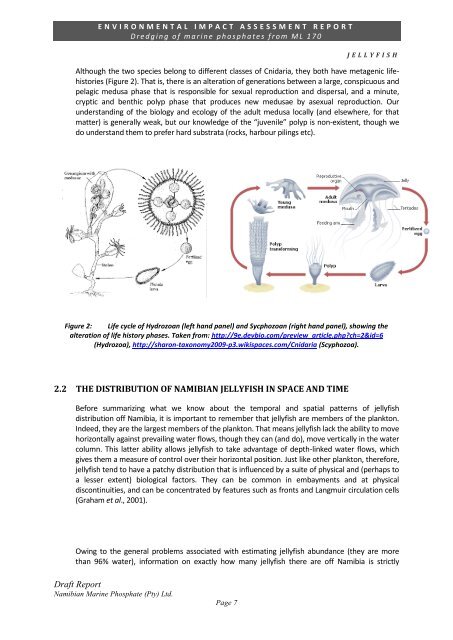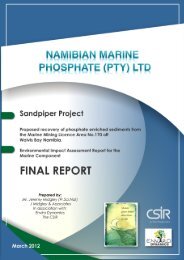Appendix 1d - Jellyfish Study.pdf - Enviro Dynamics Namibia
Appendix 1d - Jellyfish Study.pdf - Enviro Dynamics Namibia
Appendix 1d - Jellyfish Study.pdf - Enviro Dynamics Namibia
Create successful ePaper yourself
Turn your PDF publications into a flip-book with our unique Google optimized e-Paper software.
E N V I R O N M E N T A L I M P A C T A S S E S S M E N T R E P O R TD r e d g i n g o f m a r i n e p h o s p h a t e s f r o m M L 1 7 0J E L L Y F I S HAlthough the two species belong to different classes of Cnidaria, they both have metagenic lifehistories(Figure 2). That is, there is an alteration of generations between a large, conspicuous andpelagic medusa phase that is responsible for sexual reproduction and dispersal, and a minute,cryptic and benthic polyp phase that produces new medusae by asexual reproduction. Ourunderstanding of the biology and ecology of the adult medusa locally (and elsewhere, for thatmatter) is generally weak, but our knowledge of the “juvenile” polyp is non-existent, though wedo understand them to prefer hard substrata (rocks, harbour pilings etc).Figure 2: Life cycle of Hydrozoan (left hand panel) and Sycphozoan (right hand panel), showing thealteration of life history phases. Taken from: http://9e.devbio.com/preview_article.php?ch=2&id=6(Hydrozoa), http://sharon-taxonomy2009-p3.wikispaces.com/Cnidaria (Scyphozoa).2.2 THE DISTRIBUTION OF NAMIBIAN JELLYFISH IN SPACE AND TIMEBefore summarizing what we know about the temporal and spatial patterns of jellyfishdistribution off <strong>Namibia</strong>, it is important to remember that jellyfish are members of the plankton.Indeed, they are the largest members of the plankton. That means jellyfish lack the ability to movehorizontally against prevailing water flows, though they can (and do), move vertically in the watercolumn. This latter ability allows jellyfish to take advantage of depth-linked water flows, whichgives them a measure of control over their horizontal position. Just like other plankton, therefore,jellyfish tend to have a patchy distribution that is influenced by a suite of physical and (perhaps toa lesser extent) biological factors. They can be common in embayments and at physicaldiscontinuities, and can be concentrated by features such as fronts and Langmuir circulation cells(Graham et al., 2001).Owing to the general problems associated with estimating jellyfish abundance (they are morethan 96% water), information on exactly how many jellyfish there are off <strong>Namibia</strong> is strictlyDraft Report<strong>Namibia</strong>n Marine Phosphate (Pty) Ltd.Page 7
















